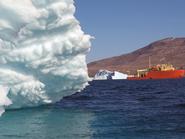
An international team of scientists - including Associate Professor of Biology Mike McCormick, alumna Elizabeth Bucceri ’11 and students Natalie Elking ’12, Manique Talaia-Murray ’12 and Andrew Seraichick ’13 - have embarked on the third cruise of the LARISSA program aboard the U.S. Antarctic Program ship Nathaniel B. Palmer.
The LARISSA project (LARsen Ice Shelf System, Antarctica), part of the National Science Foundation’s Antarctic Integrated Systems Science (AISS) department, was initiated in 2007 in response to the collapse of the Larsen B Ice Shelf in 2002. The collapse prompted scientist to discover as much as possible about the newly exposed area. It is the first interdisciplinary project funded in the AISS program of the National Science Foundation Office of Polar Programs and was officially launched in the closing days of the International Polar Year.
Scientific research in remote environments like Antarctica is especially difficult and expensive, but collaborations, such as the LARISSA project, allow geologists and biologists from a range of institutions to facilitate efficient multi-disciplinary study. The scientists thereby have greater capacity to focus on specific topics, while receiving input from their peers. Fourteen institutions and seven countries are represented among the scientists.
Three specialized groups compose the LARISSA project: Marine & Quaternary Geology, Marine Ecosystems, and Cryosphere & Oceans. Each group is focused on determining the mechanisms of the ice shelf’s collapse, as well as the consequences to previously covered ecosystems. Other projects involve the geological and biological processes of the Antarctica Peninsula.
As part of the LARISSA initiative, Hamilton College has been awarded two related NSF grants for work directed by Domack and McCormick. "Our work contributes to the understanding of these climatic changes -- where they are occurring first and with greatest magnitude and impact upon the environment," says Domack. Although he was unable to join this expedition, Domack has taken more than 100 undergraduates to Antarctica from Hamilton and other colleges and universities since 1987.
Prior to the LARISSA project during his 2004 expedition, Domack and his team discovered an underwater volcano in the Antarctic Sound. In 2005, he returned to study the causes of the collapse of the Larsen B ice shelf. This had been the original focus in 2004 when thick ice prevented access to the area. Using an underwater video sled to map the seafloor landscape during the 2005 trip, the team discovered a cold-vent chemotrophic ecosystem.
In the August 2005 issue of the journal Nature, Domack published the first evidence that the collapse of Antarctica's Larsen B Ice Shelf was unprecedented during the past 10,000 years. Using data collected from sediment core samples in the vicinity of the former ice shelf, Domack and his colleagues concluded that the Larsen ice shelf had been intact but was slowly thinning during the course of the current interglacial period.
Daily blog posts from the Hamilton participants will be posted on the 2012 expedition site.
